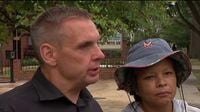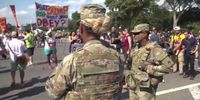In a dramatic escalation of federal intervention, Washington, D.C. is witnessing a surge of National Guard troops and federal agents on its streets, following President Donald Trump’s executive order declaring a “crime emergency” in the nation’s capital. Over the past week, the number of National Guard members deployed to D.C. has more than doubled, with additional troops arriving from Mississippi, Tennessee, Louisiana, West Virginia, South Carolina, and Ohio. The operation, now in its second week, has sparked fierce debate over its true motives, the legality of federal actions, and the impact on the city’s residents and governance.
According to the Associated Press, the latest wave of deployments was authorized on August 18, 2025, when three Republican governors—Mississippi’s Tate Reeves, Tennessee’s Bill Lee, and Louisiana’s John Bel Edwards—responded to requests from the Trump administration by sending their state’s National Guard members to assist in Washington, D.C. These new arrivals brought the total number of out-of-state Guard troops to more than 1,100, supplementing the approximately 800 members from the D.C. National Guard already on the ground. As reported by Nexstar Media, West Virginia committed between 300 and 400 troops, South Carolina pledged 200, and Ohio prepared to send 150 more, building on the president’s initial order.
The White House has framed the operation as a necessary response to what it describes as rampant crime and lawlessness in D.C. “Crime is out of control there, and it’s clear something must be done to combat it,” Mississippi Governor Tate Reeves declared in a statement, echoing the administration’s rationale for the unprecedented show of force. President Trump himself took to social media to proclaim, “D.C. has been under siege from thugs and killers, but now, D.C. is back under Federal Control where it belongs. The White House is in charge. The Military and our Great Police will liberate this City, scrape away the filth, and make it safe, clean, habitable and beautiful once more!”
Yet, this federal crackdown has not been universally embraced—even among Republicans. Vermont’s Governor Phil Scott, for example, “politely declined” the administration’s request to send his state’s National Guard troops, citing the absence of an immediate emergency or disaster. As Vermont Public reported, Scott’s chief of staff, Jason Gibbs, explained, “While public safety is a legitimate concern in cities across the country and certainly in the nation’s capital, in the absence of an immediate emergency or disaster that local and regional first responders are unable to handle, the governor just does not support utilizing the guard for this purpose, and does not view the enforcement of domestic law as a proper use of the National Guard.”
On the ground in D.C., the National Guard’s role has so far been limited to assisting law enforcement with crowd control, patrolling landmarks like the National Mall, Lincoln Memorial, and Union Station, and supporting monument security, community safety patrols, protecting federal facilities, and traffic control. Tennessee Governor Bill Lee’s office stated, “The troops are ready to assist as long as needed.” However, the sight of uniformed troops standing idly by their vehicles in typically low-crime, tourist-heavy areas has left some residents and local officials questioning the necessity and intent of the operation.
Perhaps the most contentious aspect of the deployment is the potential for National Guard troops to be armed—a significant departure from initial orders. As reported by the Army and Pentagon, the original instructions stipulated that troops would wear body armor but would not be armed or even have their weapons in their vehicles. Pentagon press secretary Kingsley Wilson assured reporters that troops would not be conducting law enforcement activities, though they could temporarily detain individuals until law enforcement arrived. Yet, a White House statement released on August 16, 2025, signaled a shift: “The National Guard troops may be armed, consistent with their mission and training, to protect federal assets, provide a safe environment for law enforcement officers to make arrests, and deter violent crime with a visible law enforcement presence.” The D.C. National Guard echoed this, stating that troops “may be armed consistent with their mission and training,” though details about timing and deployment locations remained unclear.
The operation’s scope extends beyond the National Guard. Federal agents from the Drug Enforcement Administration, Immigration and Customs Enforcement (ICE), the FBI, the Secret Service, and other agencies have been patrolling high-traffic areas, making arrests, dispersing public gatherings, and even removing pro-immigrant signs. According to the Associated Press, federal agents have arrested 160 undocumented people since the operation began, including individuals alleged to be gang members with prior felony offenses. In total, the White House has touted 380 arrests in the week since the start of the crackdown, with 137 arrests and 21 illegal firearms seized over the weekend before August 18, 2025. Attorney General Pam Bondi praised the efforts on social media: “Washington, DC is getting safer every night thanks to our law enforcement partners. Just this weekend, 137 arrests were made and 21 illegal firearms were seized. In total, there have been nearly 400 arrests—and we are not slowing down.”
Not everyone is convinced that the operation is justified or effective. D.C. Mayor Muriel Bowser has been outspoken in her criticism, arguing that the federal intervention is less about curbing violent crime and more about immigration enforcement—an issue that has become a hallmark of Trump’s second administration. “I think it makes the point that this is not about D.C. crime,” Bowser said at a news conference. “The focus should be on violent crime. ... Nobody is against focusing on driving down any level of violence. And so if this is really about immigration enforcement, the administration should make that plain.” Bowser also raised concerns about the conduct of some federal agents, who have been seen arresting people while wearing masks that obscure their identities and refusing to identify themselves when questioned by media or the public. “It’s very important to us that agents be identified,” Bowser insisted. “There’s no reason for a law enforcement official to be masked.”
The legal and political tensions have only intensified. On August 15, 2025, the city’s attorney general filed suit against the administration for appointing the head of the DEA as the city’s “emergency police commissioner”—a move the administration later rescinded, only to issue a follow-up order directing local police to “cooperate fully and completely with federal immigration authorities.” This directive contradicts local D.C. laws, further straining relations between municipal and federal officials.
Public reaction has been swift and polarized. While some residents and political allies of the president applaud the crackdown, others have taken to the streets in protest. On August 18, 2025, dozens of demonstrators gathered in the U Street neighborhood, a hotspot for recent patrols and arrests, to voice their opposition to what they see as an overreach of federal power and a militarization of the city.
As the presence of armed troops and masked agents becomes a new normal in Washington, the city stands at the center of a national debate over the limits of federal authority, the role of the military in domestic law enforcement, and the ongoing struggle between local autonomy and presidential power. The outcome of this standoff may well set a precedent for how America’s capital—and perhaps other cities—navigate the balance between security and self-governance in turbulent times.


